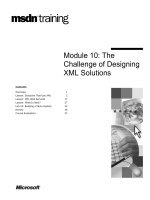Tài liệu Different Circumstances Dictate Use of Aboveground or Belowground Connectivity pptx
Bạn đang xem bản rút gọn của tài liệu. Xem và tải ngay bản đầy đủ của tài liệu tại đây (152.02 KB, 2 trang )
There are many considerations regarding the outside
plant portion of any fiber-to-the-premise (FTTP) net-
work architecture. Each area must weigh in on issues of
cost, flexibility, performance, accessibility and other
important criteria. As fiber gains momentum for use in
delivering high-speed broadband services to homes and
small businesses, questions have surfaced regarding the
best way to connect the large numbers of drop cables
feeding into the network.
Typically, drop cables connect each optical network
terminal at the subscriber premises to a fiber access
terminal, where they are then connected to a main
fiber distribution frame for routing to the central
office. The fiber plant can be either aerial (above-
ground) or buried (belowground). With an aerial
plant, the service terminal is usually mounted on a
stand or pole and technicians have easy access for
service and maintenance issues. In a buried plant,
however, the drop cable will be buried below the
frost line, yet requires the same ease of accessibility
for technicians.
The two most common methods for creating access
points while connecting buried drop cables are above
the ground (pedestal access) and below the ground
(hand hole). But there are important considerations
attached to each method, such as splicing vs.connectors,
ease of accessibility, environmental issues and the effects
of severe temperature variation.
Splicing vs. Connectors
The decision to splice or use connectors in the outside
plant has been discussed at length
—
and the pros and
cons of both methods are numerous. The basic train of
thought is that a connector pair is more beneficial at any
location where technicians may require access on a
regular basis, such as for testing, service turn-up and
reconfiguring the network.At these locations, a connec-
tor interface provides significant operational cost and
time savings over fusion splicing.
The fiber access terminal requires the advantages con-
nectors provide.There are new hardened connectors avail-
able for use in the outside plant that can withstand the
harsher environmental conditions.With new technologies
in hardened connectors, it simply makes sense to take
advantage of the benefits they bring to the outside plant.
Hand Hole vs. Pedestal Access
A hand hole is basically a hole built into the ground that
enables the technician to simply open it up and work on
the network. Hand holes are placed at any location that
would require access for maintenance, connecting addi-
tional drop cables or troubleshooting.
However, the use of an aboveground pedestal provides
even easier access for the technician. With pedestals, the
distribution cable and drop cables are still underground.
Both are brought up through the bottom of the pedestal,
and connections are made inside the unit. The obvious
34
LastMILE
May|June 2007 lastmileonline.com
Fiber Drop Cable
Connections
—
Above or Below Ground?
Fiber Drop Cable
Connections
—
Above or Below Ground?
Different Circumstances Dictate Use of
Aboveground or Belowground Connectivity
By Ray Hagen
advantage is being able to access the terminal much
easier than working through a hand hole.
Another advantage of using pedestals is cost.From a con-
struction standpoint, a typical pedestal is less expensive to
install when compared to the placement of a hand hole.
Installing a hand hole requires a large digging operation,
whereas a pedestal only takes a much smaller hole for
mounting
—
thus lowering network construction costs
significantly.The test access offered by the pedestal allows
superior access for troubleshooting or working on a
connection during the operation of the network.
One disadvantage of using pedestals is their location in
open areas where they are susceptible to vehicle
damage. Untrained technicians can also gain easy access,
as well as any curious person who may want to break in
or vandalize the pedestal or equipment. Probably the big-
ger disadvantage of using pedestals is pure aesthetics.
Neighborhoods may frown on having pedestals installed
every two to four houses and prefer that everything
remains under the ground.
Environmental Issues
In cases where pedestals may not be aesthetically
appealing or there is concern about possible damage
from vehicles or vandals, it may make better sense to
deploy terminals below the ground
—
or use a hand hole.
Inside the hand hole, another splice closure provides
additional environmental protection. The splice closure
connects the drop cables within the hand hole and,
therefore, must be substantially more robust in design as
compared to the aboveground pedestal.
The placement of hand holes below the ground line
presents more opportunity for a flooded environment,so the
ability to withstand submersion under fairly significant water
is important. It must also withstand the possibility of freezing
and thawing in northern climates.Today, there are very good
splice closures available on the market that can hold up very
well under very harsh environmental conditions.
It’s also worth noting that choosing to use hand holes in
very harsh winter environments makes them subject to
being iced over or frozen shut. It creates the possibility
that responding technicians may spend considerable time
and effort just finding a way to chip or melt the ice away
to gain access. Once open, the technician will likely find
additional ice and slush that must be cleared away before
doing any work.The point is that hand holes used under
extreme weather conditions can make maintenance
particularly difficult during the winter months.
Effects of Temperature
Severe temperature changes can have detrimental
effects on outside plant cable assemblies used in either
a pedestal or hand hole environment.This has been an
ongoing challenge for manufacturers in developing
assemblies that are hardened against the effects of
temperature. Basically, components used to construct
outside plant cable assemblies are typically made of
plastic and tend to shrink in cold temperatures.
The exposure of fiber cable and cable assemblies to low
temperatures is probably the single most common cause of
signal transmission problems and failures in outside plant
architectures. Insertion loss failures, for example, are the
direct result of cable and assembly component shrinkage
due to cold temperatures. If this shrinkage isn’t addressed
in some way during the manufacturing process and deploy-
ment planning, the optical fibers and components could
eventually fail.
As temperatures decrease to 40 degrees below zero,
the effect on cable assemblies becomes significant as
shrinkage occurs.The optical fiber in the cable, however,
remains at its original length.This can cause the optical
fiber to bunch up inside the temporarily shortened
assembly.The result is that fiber can be severely stressed,
causing micro-bends and high insertion loss at 1550 nm.
In some cases, a fiber break could even occur.
Since everything is below ground with a cover acting
as an insulator for the fiber cable, drops, and interfaces,
the hand hole access method provides some inherent
protection against cold temperatures. In a pedestal envi-
ronment, however, temperature changes are much more
apparent.The temperature inside the pedestal will likely
be as cold as outside temperatures in the winter, and
probably warmer in the summer, since the enclosure
itself heats up if exposed to direct sunlight.
Therefore, it’s important for network architects to con-
sider temperature challenges at each network location
and their possible effects on drop cable connections.
Whether they choose hand holes or pedestals for drop
cable connections, these are critical points of the FTTP
network and must be protected against potentially
harmful environmental characteristics.
The industry has made huge advances in access
equipment and connector components that meet or
exceed specifications for dealing with every environ-
mental situation faced by FTTP networks, particularly
in the outside plant.A little planning goes a long way
in ensuring optimum performance, accessibility, and
flexibility for driving the benefits of fiber directly to
consumers.
Ray Hagen is product manager for FTTX OSP hardened
products in fiber cable management in the Global Connectivity
Solutions Group at ADC (www.adc.com), headquartered in Eden
Prairie, Minn.
May|June 2007
LastMILE
35lastmileonline.com
The most common methods for creating access points while
connecting buried drop cables are belowground hand holes
(left) and aboveground pedestal access.









